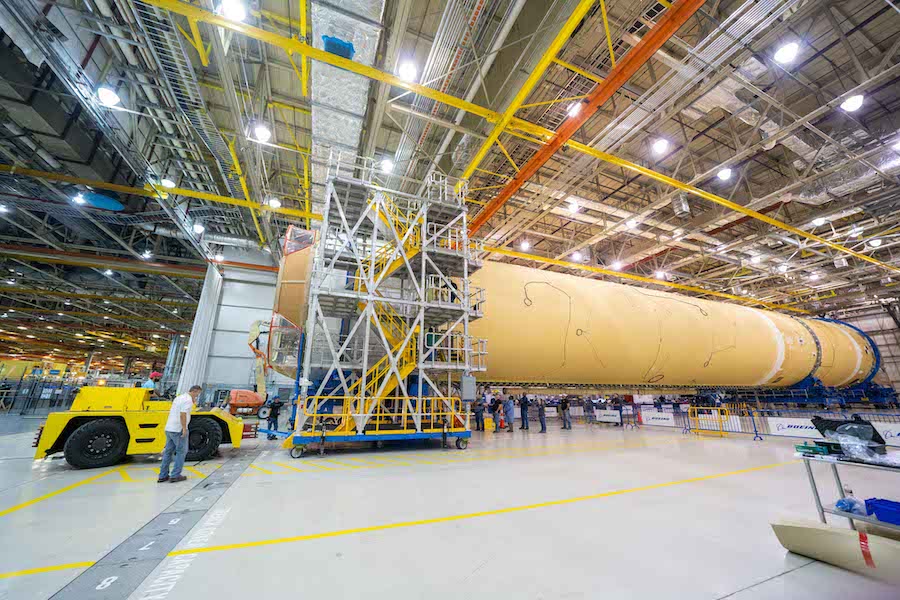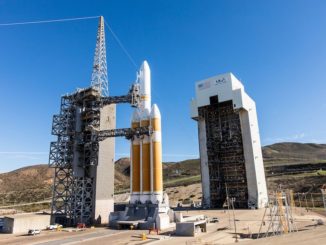
A steel tube built as a stand-in for the core stage of NASA’s Space Launch System has arrived at the Kennedy Space Center for a series of rehearsals to hone the skills of technicians before the real rocket reaches the spaceport, an oft-delayed milestone that could still be a year or more away.
The steel cylinder, fitted with four bell-shaped structures in place of real rocket engines, arrived at the Florida spaceport Friday aboard NASA’s Pegasus barge.
The vessel carried the SLS core stage pathfinder rode the Pegasus barge from NASA’s Stennis Space Center in Mississippi, where ground teams practiced handling the rocket simulator and lifted the structure into a test stand that will be used next year by the actual rocket.
A similar series of rehearsals at the Kennedy Space Center will allow technicians to practice procedures to raise the core stage vertical using cranes inside the Vehicle Assembly Building, where the Space Launch System will be assembled on top of a mobile platform before rolling out to pad 39B for final countdown operations.
Workers practiced loading and unloading the core stage pathfinder on the Pegasus barge several times Monday at the turn basin wharf at Kennedy, before moving the rocket simulator into the VAB on Tuesday. The Pegasus barge and the turn basin wharf were previously used to ferry and unload the space shuttle’s external fuel tanks after shipment from their factory in Louisiana.
NASA lengthened the Pegasus barge to accommodate the SLS core stage.
The steel pathfinder is a full-scale mock-up of the SLS core stage, stretching 212 feet (64.6-meters) long and 27.6 fleet (8.4 meters) wide. It weighs around 228,000 pounds, or 103 metric tons, according to NASA.

The Space Launch System is a heavy-lift rocket in development since 2011 designed to loft NASA’s Orion crew capsule on trajectories into deep space. The Trump administration has charged NASA with landing astronauts on the moon by the end of 2024, and the space agency says it needs the SLS to launch Orion crews in order to achieve that deadline.
But the rocket’s first flight is more than three years behind schedule after missing its original target launch date in 2017.
John Honeycutt, the SLS program manager at NASA’s Marshall Space Flight Center in Huntsville, Alabama, said Sept. 26 that the the rocket’s team is working “aggressively” to meet an internal schedule that could result in a November 2020 launch date for the first test flight, named Artemis 1.
The November 2020 schedule is probably unachievable, and does not take into account any possible setbacks during a critical period of vital tests over the coming months.
NASA is expected to set an official target launch date for Artemis 1 later this year, once a new associated administrator for the agency’s human spaceflight programs is selected. That new official target launch date for Artemis 1 is likely to be some time in 2021, factoring in extra time to deal with technical issues.
Artemis 1 is an unpiloted mission that will send the Orion spacecraft into around the moon. If it goes well, NASA wants to launch four astronauts on a mission around the moon and back to Earth on the next SLS/Orion mission, designated Artemis 2, in 2022 or 2023. Artemis 3 would carry astronauts to rendezvous with a lander launched into lunar orbit on a different rocket, before attempting the first human landing on the moon since 1972.
NASA decided to build a pathfinder to familiarize technicians at Stennis and Kennedy with handling a structure with the same dimensions of the SLS core stage because the first real rocket will be the stage destined to launch on the first SLS test flight, not a ground development unit.
Honeycutt compared the first SLS core stage to a “golden egg.”
“It was important to us to get a pathfinder and hand it over to the team so they could work through the operations of doing the lift to get the core stage into the test stand (at Stennis) and learn from that,” Honeycutt said.
“We’ll do the same thing at Kennedy,” he said. “We’ll hand the pathfinder over to the EGS (Exploration Ground Systems) folks, and they’ll start doing their practice operations on the core stage well ahead of time before the actual core stage ends up there.”
The pathfinder rehearsals in the VAB are expected to last about a month, NASA said.

Exactly when the Boeing-built SLS core stage itself will arrive at the Florida launch site remains unpredictable, officials said.
Last month, workers at the Michoud Assembly Facility in New Orleans finished connecting the major segments of the SLS core stage. The engine section, which sits at the base of the rocket, was the final significant element of the core stage added.
“The engine section has been our critical path for the last two years,” Honeycutt said. “It’s very complex. It’s analogous probably to what we used to call the aft compartment of the space shuttle orbiter. It’s a spacecraft in and of itself. It houses control systems, avionics, for all the propulsion, the autogenous pressurization system, auxiliary power, as well as those four big main engines, and the hydraulic actuators that are used for pitch and yaw on the engines.”
Difficulties in fabricating and outfitting the engine section contributed to most of the recent delays in the first SLS test flight.
Teams at Michoud will install the core stage’s four Aerojet Rocketdyne RS-25 main engines in the coming weeks. The engines are leftovers from the space shuttle program, and were designed to be reusable.
But like the rest of the core stage, the engines will be thrown away with each SLS flight.
Once the engines are on the rocket, engineers will begin final integration and testing on the core stage, according to Honeycutt.
“There’s a systems tunnel that runs the full length of the stage that’s got a significant amount of cables, connectors, and so forth,” he said. “All of that’s got to be be checked out from the top of the rocket to the bottom and make sure we’ve got everything working correctly.”
When that’s done, the Pegasus barge will ferry the core stage from Michoud the nearby Stennis Space Center for mounting inside the B-2 test stand to begin a series of tests known as the “green run.” NASA would like to have the core stage at Stennis by the end of this year.
After the green run testing in Mississippi, the Pegasus barge will haul the core stage to Florida for final checkouts and stacking on top of the SLS mobile launch platform, a process expected to take at least several months.

Controllers will conduct launch dress rehearsals at Stennis. The testing will begin with loading super-cold liquid hydrogen and liquid oxygen into the core stage for the first time.
The months-long green run campaign will culminate in a full-duration test-firing of all four RS-25 engines on the test stand. The engines will generate 2 million pounds of thrust at full power and fire eight minutes during the green run hot fire test, just as they will during launch.
On a real launch, two solid-fueled boosters will be affixed to each side of the core stage. A hydrogen-fueled second stage and Orion spacecraft will be bolted on top.
Honeycutt said the green run testing is “very complex,” and the most complicated element is a part called the stage controller, a computer that oversees all the moving parts of the core stage.
“The stage controller makes the core stage think it’s sitting on the launch pad in a launch environment at the Kennedy Space Center,” Honeycutt said. “It’s been a significant amount of effort to run through the software development for the stage controller.”
In a presentation last week to the National Academies’ Aeronautics and Space Engineer Board, Honeycutt hinted at challenges in readying the stage controller’s software for the green run test.
“The team has turned the tide, I believe, and is starting to do really good, but we’re having to pay really close attention to the stage controller for green run,” he said.
In parallel, engineers at Marshall are putting test articles for each of the SLS core stage elements — the engine section, liquid hydrogen tank, intertank and liquid oxygen tank — through structural testing. Honeycutt said the liquid oxygen tank is the final piece to go through structural testing, and that should be finished in early 2020.
He said the liquid oxygen tank’s structural testing is not a hang-up for the green run at Stennis.
Inside the factory at Michoud, Boeing was able to catch up on some of the core stage work delayed by problems building the engine section by rearranging how the rocket was assembled. Instead of mating the engine section vertically to the bottom of the hydrogen tank, then connecting that to the other half of the core stage, managers decided to connect the all the pieces of the rocket — minus the engine section — earlier this year.
While the replan bought managers some time at Michoud, it means technicians may have to complete a delicate final assembly task outside the factory, once the core stage is vertical again at the Stennis Space Center.
“The original plan was to mate the engine section to the hydrogen tank, lay the hydrogen tank down, and mate the back half of the rocket with the front half of the rocket,” Honeycutt said. “Given the challenges we had with the engine section … that made us go have to do the engine section mate horizontally as opposed to vertically, which makes it very challenging to make the feedline connections inside the engine section.
“That’s the type of work that’s getting transferred to Stennis,” he said. “It’ll be similar to working at the factory, but we all know that the factory is probably the best place to do the work, except in this one case.
High volumes of propellant will flow through the liquid hydrogen and liquid oxygen feedlines into the RS-25 engines.
“My message to the Boeing folks, and they get it, is if the right place is in the factory, we’re going to stay in the factory and do the work (with the feedlines),” Honeycutt said.
Honeycutt identified several possible “pinch points” during the green run testing at Stennis that could lead to further delays.
The schedule assumes some delays for minor problems or bad weather.
“But I haven’t baked anything into the schedule for big anomalies like multiple attempts at hotfires, or multiple attempts at wet dress rehearsal, or a significant hydrogen or oxygen leak,” Honeycutt said. “So there are your big pinch points through green run. If everything goes right, we can probably get out of there in five months or so. History would tell us it’s probably somewhere in between five months and 10 months.
“Other pinch points after we get to Stennis, they’re primarily the unknown unknowns, right? We’ve had a lot of them in the factory.”
Email the author.
Follow Stephen Clark on Twitter: @StephenClark1.



